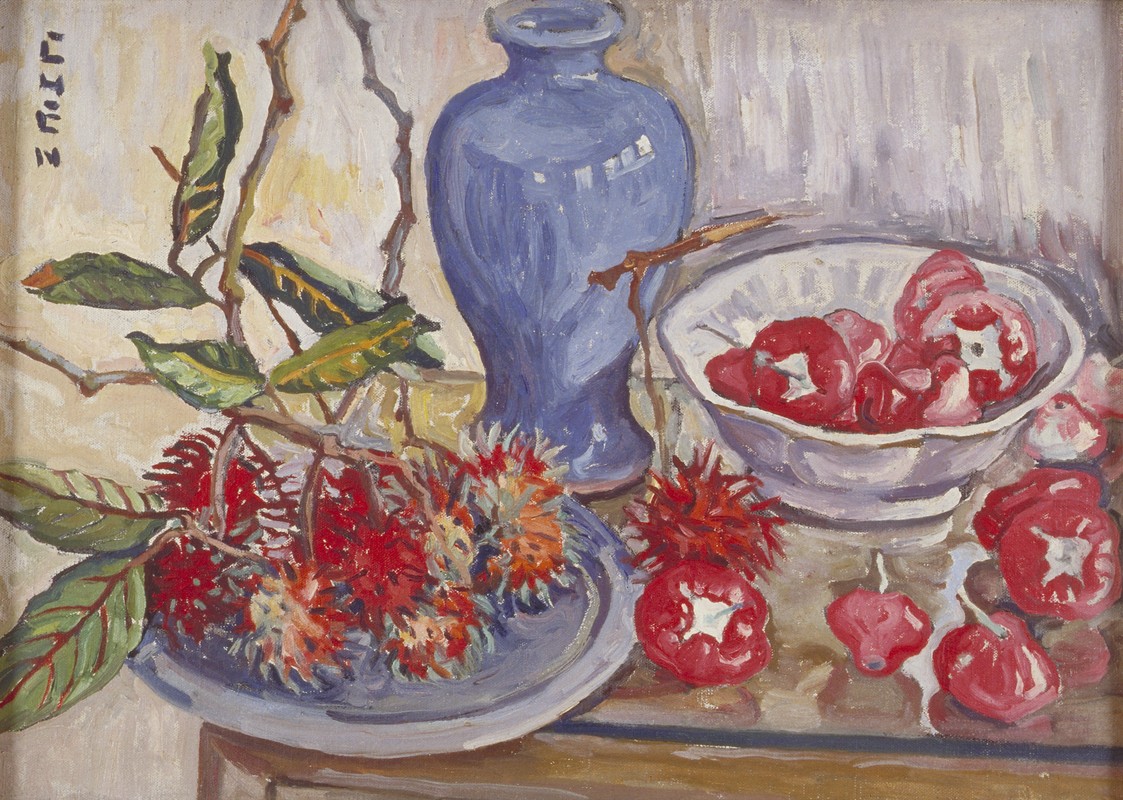先驱画家:张汝器
张汝器(1904-1942)是战前新加坡最重要的画家之一,也是新加坡华社美术活动的重要推手。
张汝器出生广东潮安,其父张寅伯(生卒年不详)擅长工笔画,从小受家庭熏陶,喜爱绘画。张汝器于上海美术专科学校学习西洋画,肄业后到法国马赛美术学院进修。1927年,张汝器寓居新加坡,先后执教于端蒙学校和养正小学。
1929年,《星洲日报》初创,张汝器受主笔朱宝筠(生卒年不详)之邀,常发表漫画作品于《星洲日报》的《繁星》副刊。同年7月,该报为提倡美术、并增进读者兴趣,进一步出版图画副刊《星光》,由张汝器担任主编。这时期《星洲日报》的副刊如《繁星》《野葩》以及青年励志社借《星洲日报》出版的《青年》,各版版头皆由张汝器设计。《椰林》副刊的版头,也由张汝器重新设计。1930年,张汝器辞去《星光》编辑,总共编了一年两个月。同年,张汝器好友陈炼青(1907-1943)编《叻报》时,增设《椰晖》画刊,由张汝器主持,持续半年,后因经费停刊。

“汝器画室”与“朋特画室”
1929年杪,张汝器辞去学校教职,1930年2月11日创办“汝器画室”。1930年2月18日,《星洲日报》刊登了一则“汝器画室”的广告。从广告的文字,可见当时的文化人如张叔耐(1895-1939)、方怀南(生年不详-1942)、陈炼青、傅无闷(1892-1965)等,对张汝器的才艺甚为推崇。
汝器画室主要为商家绘制美术广告,也开班授课。《星洲日报》的《星光》副刊也刊登了不少张汝器学生的漫画作品。1933年,张汝器与其妹夫庄有钊(1907-1942)共同创立“朋特画室”,为商家绘制广告。
“绘画应有地方性”:以南洋景物入画
居住在新加坡时,张汝器积极参与本地和外地的展览。他的参展作品不少是油画,或和他留学法国有密切关系。
从现存文献而言,张汝器是很早且有意识地以南洋景物入画的画家。他为《叻报》设计的《椰林》副刊版头,以椰林为主题,既切合刊名也凸显了陈炼青一再倡议的“文学应有地方性”的思潮。陈炼青在《地方色彩与文艺》一文中认为南洋风光如苍翠的椰林、浓密的橡胶、茂盛的芭蕉、耸立的老树,以及一雨成秋的气候都是写作人的好题材。陈炼青在《张汝器先生》一文中提到:“椰,虽然纤长的枝叶,柔弱的姿态。可是在张汝器先生画起来,却纤长之中带有豪劲,柔弱之中又反映雄健。这真切合我们在南洋生活之下的一种象征。”2

张汝器在新加坡的日子虽然短暂,但艺术生活却是绚丽的。在新加坡生活一段日子后,他对本地的艺术发展,有强烈的社会使命感。1930年他负责编《叻报》图画副刊《椰晖》时,在该刊的《前言》中写下一篇无疑是向美术界战斗的“檄文”,是他社会使命感的表现:“现在的艺坛是一个沙漠,这么荒凉,这么干涸!然而,在这沙漠中,我们渴求着生之泉……虽则,脚步那般迂缓,还是负着重大的使命。一步一步地前进,永远没有倦意……”。《椰晖》的版头还写上“Slow but Sure”(“缓慢却坚定”)。

张汝器的作品不乏《马来女儿》《杂锦豆小贩》《南国佳人》《静物》《孟加里像》《吉宁老人》《亚答屋》《椰影》《苦力》等,是画家热爱本土生活的表现。陈宗瑞(1910-1985)写到张汝器的作品:“构图独具匠心,人物神态栩栩,线条运用无不恰到好处,色调强弱层次,准切简练,观其马达山所作风景图,顿觉凉风习习,极表达之能事,穷造化之神功”。3

华人美术研究会
战前的华人美术研究会、南洋美术专科学校,对推动新加坡美术的发展,贡献甚大。张汝器历任华人美术研究会主席(1936、1937、1938、1940),对会务的发展,有很大的功劳。华人美术研究会被视为新加坡第一个组织健全的美术团体,会员之中,不少从事艺术教育,任教于当时各中小学。除了张汝器外,还包括陈宗瑞(端蒙学校)、叶之威(1913-1981;中正中学)、黄清泉(生卒年不详;工商学校)、吴在炎(1911-2001)和颜再声(生卒年不详;道南学校)等。张汝器也曾在南洋美专授课,为培养下一代美术人才尽一己之力。
画家刘抗(1911-2004)如此评价张汝器:“他是全马(编按:马来亚)画家中写实技巧最圆浑成熟的一员,可与悲鸿、巴苏基(编按:印尼画家)并肩齐步,而神韵风采则过之无不及,所作人物栩栩如生,已达到勾魂吸魂之境界。”4
1942年,日据时期,张汝器在肃清大屠杀中惨遭杀害,结束其短暂的一生。
| 1 | 张识芬为张汝器的女儿。 |
| 2 | 《叻报》副刊《椰林》,1929年1月18日。 |
| 3 | 《陈宗瑞诗文集》(新加坡:陈其新出版,2010),页23。 |
| 4 | 刘抗,《刘抗文集》(新加坡:教育出版社私营有限公司,1981),页237。 |
“张汝器”。新加坡国家图书馆管理局远程参考咨询服务站。 | |
姚梦桐,〈观国家美术馆“南洋遐想”之张汝器故事〉。《联合早报》,2016年1月1日。 |










